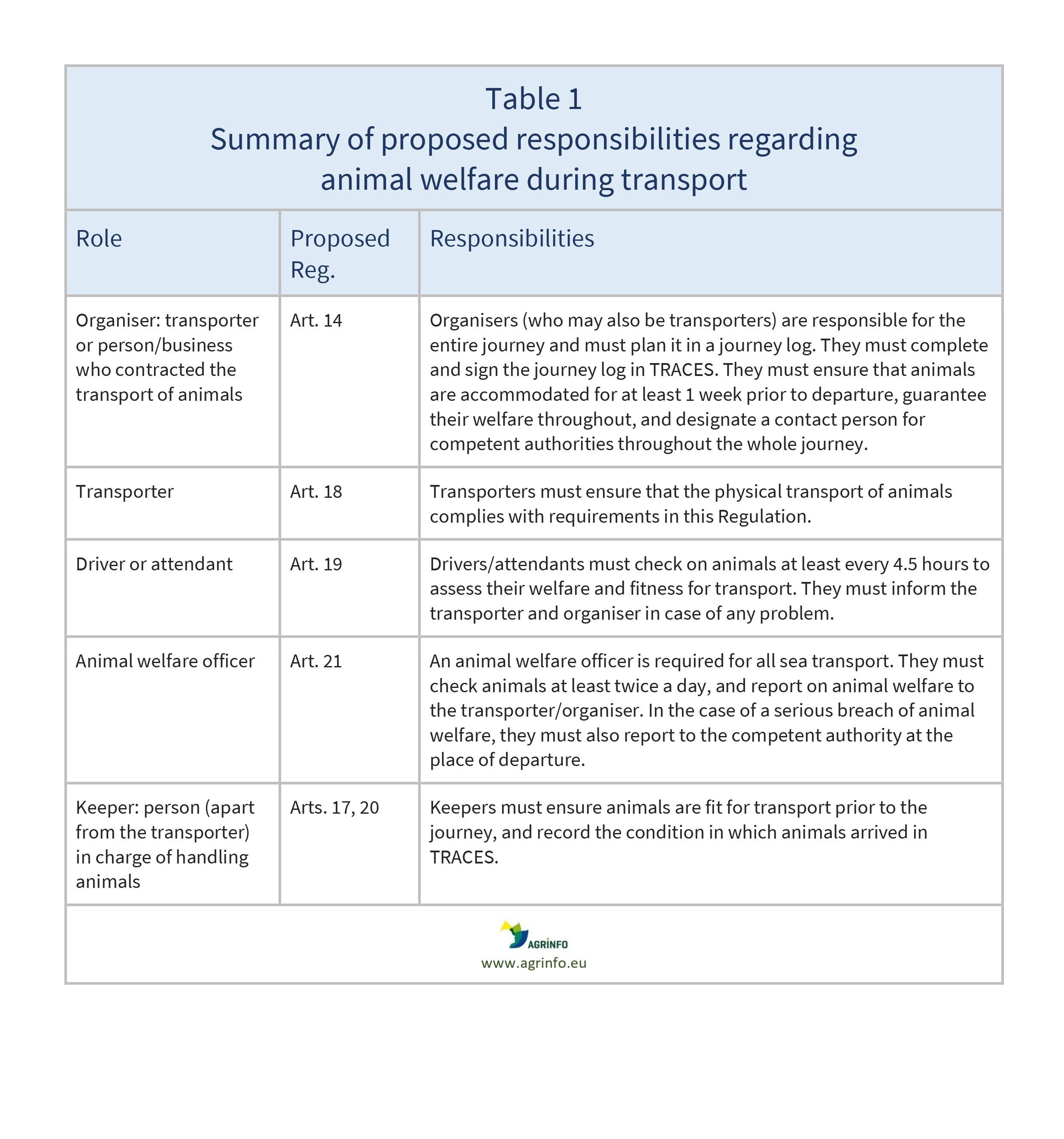Animal welfare during transport
Published by AGRINFO on ; Revised
EU proposes new rules on protecting animals during transport including imports
Proposal for a Regulation of the European Parliament and of the Council on the protection of animals during transport and related operations, amending Council Regulation (EC) No 1255/97 and repealing Council Regulation (EC) No 1/2005
Update
This proposed Regulation aims to reinforce existing animal welfare rules during transport. Whereas the current rules (Regulation 1/2005) do not apply to live animals imported into the EU from non-EU countries, the proposed rules will also apply to imported animals.
The European Commission’s proposal sets out detailed requirements on all aspects of animal welfare during transport, including the fitness of animals for transport, the quality and safety of vehicles and equipment, time limits for journeys, temperatures, feeding and watering, and space allowances.
The proposed rules will require non-EU transporters of animals to apply for an authorisation to transport animals. Non-EU competent authorities will be required to certify that journey plans for animals meet conditions that are at least equivalent to those required by the proposed Regulation.
Feedback on this proposal closed on 12 April 2024.
Impacted Products
Sheep, goats, horses, cattle, pigs, poultry, rabbits, cervids (deer), fish, cephalopods (squid, octopus, etc.), decapods (crustaceans)
What is changing?
The EU’s rules aimed at protecting animals during transport are currently set out in Regulation 1/2005. This new proposal aims to reinforce those requirements and extend their scope to include:
- live animals imported from non-EU countries (as well as those exported from the EU)
- additional species such as fish, cephalopods (squid, octopus), and decapods (crustaceans).
Key obligations
Key obligations for the transport of animals from non-EU countries to the EU within the proposed Regulation (Arts. 5 and 35) are as follows.
For businesses:
- Transporters of animals must have authorisation from one EU Member State to transport animals to the EU.
- From the place of departure to the destination, transporters must ensure that the conditions in which animals are transported are at least equivalent to those set out in the Regulation.
- Transporters must complete a journey log in the EU’s online TRACES certification system, specifying the place, date, and time of departure from the non-EU country.
For non-EU competent authorities:
- The health certificate accompanying animals exported to the EU must include an attestation (formal statement) from the competent authority at the place of departure that the journey plan is at least equivalent to the requirements in the Regulation.
- For long journeys, the competent authority at the place of departure must review the journey log prior to departure and approve it in the TRACES system.
Responsibilities
Annex I to the Regulation specifies the responsibilities of those involved in transporting animals, as summarised in Table 1.
Authorisations
To be able to transport animals to the EU, the organiser must receive authorisation from one EU Member State (there is no need to apply to multiple Member States). The organiser must be represented by a legal entity in that EU Member State: that is, they must either have their own office in that country, or give a mandate to an operator or organisation in that country to represent them. They must also be able to demonstrate that they can fulfil their responsibilities (Art. 14). Authorisations are valid for 5 years. To transport large animals by road, rail, or sea, an additional certificate of approval is required (Arts. 12, 13).
Requirements for animal welfare during transport
Annex I to the Regulation sets out detailed requirements for all aspects of the welfare of animals during transport, as summarised in Table 2. Requirements can vary according to species.
It should be noted that the proposal also covers exports to non-EU countries, and transport of cats and dogs; this trade falls outside the scope of AGRINFO.
Why?
Repeated breaches of existing animal welfare rules (Regulation 1/2005) have been widely publicised in the media and led to much public debate. Both the European Parliament and the Council have called on the Commission to revise the EU legislation. The Commission responded with a Fitness Check Roadmap for animal welfare legislation. It regards stricter animal welfare standards as one of the sustainable agricultural practices necessary to achieve the objectives of the Farm to Fork Strategy.
Timeline
The Commission proposal was communicated to the European Parliament and Council (co-legislators) on 7 December 2023. It will be discussed and amended before adoption by the European Council (made up of the EU Member States) and the European Parliament. If institutions broadly agree on the proposal, this process is usually completed within 18 months. If there is significant disagreement, the process can last up to 40 months.
The Regulation will apply 2 years after it is adopted and published, with a longer transition period likely for certain requirements.
What are the major implications for exporting countries?
The proposal applies EU animal welfare requirements to imported animals for the first time.
Organisers/transporters of animals
For non-EU countries exporting live animals to the EU, the proposed new rules would require organisers/transporters of animals to:
- register their businesses in one EU Member State
- apply for authorisation to transport the animals and, where relevant, apply for certificates approving the means of transport (road, rail, or sea vessels)
- evaluate current transport practices and ensure that conditions are at least equivalent to those set out in the new Regulation
- prepare for additional administrative responsibilities associated with completing journey logs in TRACES
- organise the training of all responsible persons involved in animal transport (keepers, organisers, transporters, drivers, attendants, animal welfare officers)
- coordinate with local competent authorities on the certification of control posts where animals are rested during the journey
- equipment and vehicles potentially may need to be adapted or replaced. For example, trucks with one deck could not be used for exports to the EU due to new height requirements
- practices may need to change to extend the time period animals stay at the place of departure prior to transport.
Competent authorities
Non-EU competent authorities would need to:
- train staff to evaluate and certify journey plans
- organise the administration of attestations that must be included in official health certificates accompanying animals exported to the EU
- ensure that control posts in non-EU countries where animals are rested during the journey meet the requirements of the Regulation, and are certified and approved by the European Commission.
Recommended Actions
Transporters and competent authorities should assess the potential impacts of these proposed requirements on existing arrangements for transporting animals.
Feedback on this proposal closed on 12 April 2024 (see Animal welfare – protection of animals during transport). This feedback will be summarised by the Commission and presented to the European Parliament and European Council to feed into the legislative debate.
Although these new rules will not apply until 2028 at the earliest, transporters of animals should start to review existing practices and consider potential strategies for key aspects that may not be compatible with the proposed requirements.
Background
The current legislation on the protection of animals during transport was adopted in 2004 (Regulation 1/2005).
In the framework of the Farm to Fork Strategy, the EU announced its intention to align the rules with the latest scientific evidence, broaden their scope, facilitate enforcement, and ultimately ensure a higher level of animal welfare.
In October 2022, the European Commission published the results of the Fitness Check of the EU Animal Welfare legislation. This Fitness Check showed that significant developments in science and technology, shifts in societal preferences, and increasing sustainability challenges are not reflected in the current Regulation, and the current rules are difficult to implement and enforce.
An Impact Assessment Report was published alongside this Proposal on 7 December 2023.
In parallel, the World Organisation for Animal Health (WOAH) monitors, develops, and implements animal welfare standards.
Resources
EFSA (2022) More space, lower temperatures, shorter journeys: EFSA recommendations to improve animal welfare during transport [with links to plain language summaries of five EFSA Opinions]. European Food Safety Authority.
European Commission:
- Fitness Check Roadmap: Fitness check of the EU legislation on animal welfare of farmed animals
- Fitness Check of the EU Animal Welfare legislation
- Impact Assessment Report accompanying the document Proposal for a Regulation of the European Parliament and of the Council on the protection of animals during transport and related operations, amending Council Regulation (EC) No 1255/97 and repealing Council Regulation (EC) No 1/2005
- Commission proposes new rules to improve animal welfare (press release 2023)
- Protection of animals during transport
European Parliament:
- Committee of Inquiry on the Protection of Animals during Transport
- Report on the investigation of alleged contraventions and maladministration in the application of Union law in relation to the protection of animals during transport within and outside the Union
- European Parliament recommendation of 20 January 2022 to the Council and the Commission following the investigation of alleged contraventions and maladministration in the application of Union law in relation to the protection of animals during transport within and outside the Union
European Council:
World Organisation for Animal Health (WOAH):
Sources
Proposal for a Regulation on the protection of animals during transport and related operations




